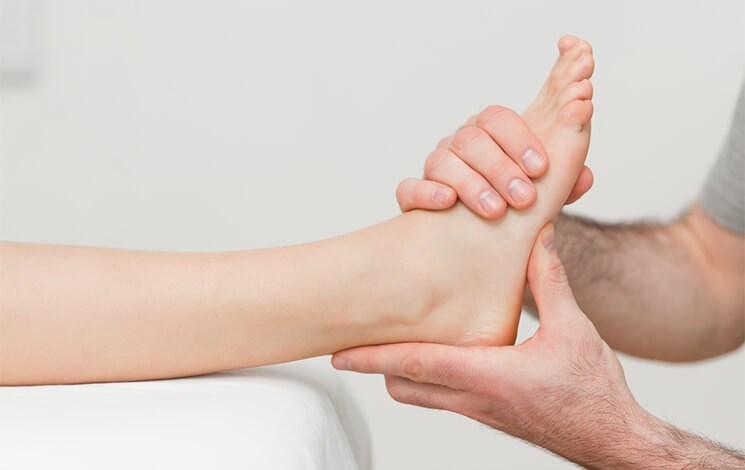It starts with a stabbing pain the moment you get out of bed to take the first few steps of the day. Also referred to as a heel spur, plantar fasciitis represents one of the most common sources of heel injuries. Inflammation of a thick band of soft tissue covering the bottom of either foot can negatively impact professional athletes, as well as people that enjoy active lifestyles. After you rise from bed or stand up from a chair and move around for a couple of minutes, the pain generated from a heel spur might subside. However, the pain can return even stronger later in the day for people that stand or sit for extended periods

Associated with sprinters and long distance runners, plantar fasciitis produces symptoms that should motivate you to seek immediate medical attention. As the most common symptom, pain that shoots through the bottom of the foot near the heel can send the stoutest athlete to the sideline.
Although a heel spur can trigger immense pain during a workout or an athletic event, it usually manifests after hours of sleep. Plantar fasciitis pain becomes acute after exercising, not during a workout. If you experience foot and/or heel pain during a workout, then some other type of foot/heel ailment has most likely triggered the pain. If you stand for most of the day, you can create the right conditions for heel pain to develop overnight.
When the plantar fascia acts under normal conditions, it works like a bowstring that absorbs the pounding inflicted on the feet and heels. If the pounding becomes too much for the elastic bowstring, small tears develop in the plantar fascia. Continued stress placed on the foot and heel can produce a severe case of plantar fasciitis. What causes intense pounding on the foot heel? The most common cause of a heel spur is sports that require considerable running, such as soccer, tennis, and long distance races. Inadequate arch support for the foot in the form of frequently walking barefooted can also produce a heel spur.
Although plantar fasciitis can happen without a cause you can easily detect, numerous risk factors can contribute to the development of the stabbing pain that can force you out of a game or prematurely end a nightly run around the nearest track.
Age-People between the ages of 40 and 50 are the most likely candidates to suffer from plantar fasciitis.
Type of exercise-Recreational activities that place a tremendous amount of stress on the tissue attached to the heel, such as aerobic dancing and long distance running, contribute to the development of plantar fasciitis.
How the Foot Turns-Foot mechanics play a huge role in determining the likelihood of the onset of a heel spur. If you run or walk flat-footed or simply walk in a pattern that deviates from the norm, you are at a higher risk of contracting plantar fasciitis.
Overweight-the more your weight is above average for your size, the more stress you place on the sensitive plantar fascia
Your job-Any professional that stands on his or her feet throughout the day significantly increases the chances of developing a heel spur. Teachers, factory workers, and restaurant employees represent three categories of occupations that increase the chances of plantar fasciitis development.
“Nip it in the bud” is a common expression that emphasizes a sense of urgency. The same expression is appropriate for addressing the health care issues created by plantar fasciitis. Many athletes like to “shrug it off” when it comes to handling pain. You cannot have that mindset when you experience a stabbing sensation in the foot near the heel. The highly rated team of chiropractors at Perry Chiropractic Health Center strongly urges our patients to receive a prompt diagnosis for acute foot and/or heel pain. We will conduct a thorough examination that determines whether you suffer from the pain caused by a heel spur. We will conduct a thorough examination that determines whether the pain you suffer from is caused by a heel spur.
The primary goal for plantar fasciitis treatment is to restore the full range of motion you enjoyed before the heel injury. We work on the soft tissue surrounding the plantar fascia to reduce the stress placed on the elastic-like bowstring that provides a solid foundation for absorbing the pounding experienced by both feet. Ice massage prevents additional damage to the plantar fascia, while stabilizing the bowstring-like soft tissue surrounding the heel. As with many leg and foot injuries, time is the elixir for plantar fasciitis symptoms that at first mitigates, and then eventually eliminates the stabbing pain.
Schedule an initial consultation today with one of the licensed chiropractors working at Perry Chiropractic Health Center. The key to treating plantar fasciitis is to receive a diagnosis as soon as possible after experiencing one or more symptoms of the ailment.
Hours:
Mon – Fri: 8:00 am – 6:00 pm
Hours:
Mon – Fri: 8:00 am – 6:00 pm
Saturdays 8 am - 12 pm